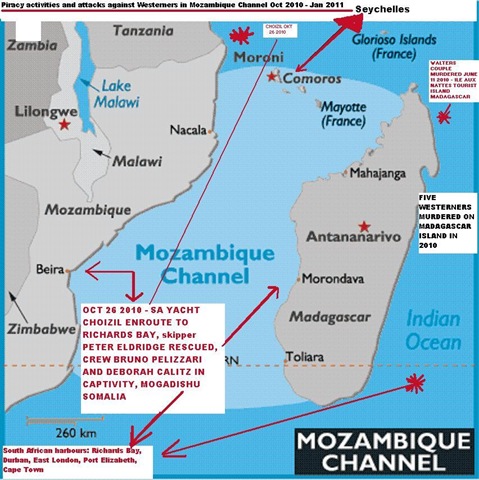Mozambique Channel
LOCATED OFF the country of MOZAMBIQUE in Africa, the Mozambique Channel lies within the INDIAN OCEAN, between the African continent and the island of MADAGASCAR. The currents in the Mozambique Channel usually form an anticyclonic system but sometimes they do flow directly south into the Agulhas Current off the coast of SOUTH AFRICA. This area is a seismically active region that is thought to be an offshore continuation of the eastern branch of the East African Rift. On April 29, 1952, a 6.0-magnitude EARTHQUAKE struck within the Mozambique Channel, and since then several earthquakes of this magnitude and higher have been recorded.
The Mozambique Channel is narrowest at 250 mi (400 km), across from the African mainland at Mozambique to Madagascar. Within the channel flows the Mozambique Current, which takes warm water from the South Equatorial Current to the north and moves it south along the coast of Mozambique, then in a counterclockwise circle, back up the channel moving north along the coast of Madagascar. During the monsoon season in October and November, this current has the potential of attaining velocities exceeding 3.7 mi (6 km) per hour. The tidal ranges in the channel can be up to 21 ft (6.4 m), with surface temperatures varying seasonally between 71.6 degrees F (22 degrees C) and 80.6 degrees F (27 degrees C).

The marine life in the Mozambique Channel is extremely diverse thanks to the warm water currents of the area. There have been more than 2,000 species of fish identified in the channel, along with 180 species of birds. Five different types of marine turtles live in the waters of the Mozambique Channel: Pacific green, loggerhead, hawksbill, leatherback, and olive ridley. There are also many types of dolphins, invertebrates, and macroalgae. Southern right whales migrate through the channel, while humpback and minke whales live yearround here. The marine habitats of the Mozambique Channel include coral reef, sandy beach, rocky shore, seagrass beds, and deep water.
It is generally agreed that Madagascar once was linked to the African mainland. The Mozambique Channel is underlain by continental crust, layers of sandstone and limestone, which are thought by many researchers to have once been bridges from Africa to Madagascar. There is some debate as to when exactly Madagascar moved to its present position, with the spreading of the Mozambique Channel. Some researchers say it was during the Cretaceous period and others say it was during the early to middle Cenozoic.